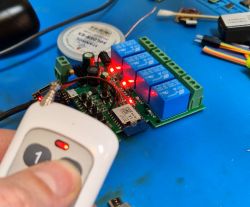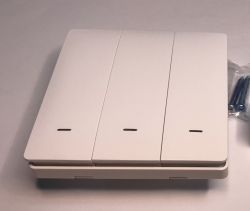FAQ
TL;DR: For one lamp use a 1‑channel module; for two, a 2‑channel—"How many devices it will control - e.g. 2 lamps or 1 lamp." Choose WiFi+RF for simple, stable remote-and-app control. [Elektroda, sk1977, post #19866717]
Why it matters: This FAQ helps DIYers and installers pick a reliable in‑box light controller that works with remotes, apps, and existing wall switches.
Quick Facts
- Most in‑box smart relays need a Neutral (N) in the switch box; without N your options narrow. [Elektroda, sk1977, post #19825074]
- WiFi+RF combos are “the simplest solution and the most stable and reliable” for lamp control. [Elektroda, sk1977, post #19825074]
- BleBox switchBox controls 230 V loads up to 3600 W. [“switchBox – niezawodny włącznik WiFi 230V 3600W”]
- BleBox also offers a two‑channel “D” version to control two devices. [Elektroda, exti, post #19870827]
- Tuya QL modules come in 1‑ and 2‑channel variants with inputs for traditional switches. [Elektroda, automatapl, post #19862554]
What’s the simplest way to control one lamp by remote and app?
Install a WiFi+RF in‑wall relay in the switch box. Pair it with an RF handheld remote and your phone app. This approach is simple, stable, and reliable. Options discussed include Tuya QL modules, Sonoff RF glass switches, and BleBox switchBox with µRemote. Ensure the relay fits your box and load. [Elektroda, sk1977, post #19825074]
Do I need a Neutral (N) wire in the box?
Usually yes. Most in‑wall relays power themselves from Line and Neutral. Without N, you must pick specialized no‑neutral models. As one expert put it, “Check you have an N wire in the box before choosing.” Verify wiring before purchase. [Elektroda, sk1977, post #19825074]
How do I choose between 1‑channel and 2‑channel controllers?
Match channels to circuits. Use one channel for one lamp, or two channels for two independent lamps. Or split a two‑circuit fixture. As noted, “How many devices it will control - e.g. 2 lamps or 1 lamp.” Leave expansion room if you might add a second circuit. [Elektroda, sk1977, post #19866717]
Can I still use a traditional wall switch alongside the remote and app?
Yes. Choose a module that accepts a traditional switch input. Tuya QL has 1‑channel versions for a standard switch and 2‑channel for a two‑pole switch. Wire the switch input according to the manual. This lets you toggle locally even after remote actions. [Elektroda, automatapl, post #19862554]
Which remotes work with Tuya QL or similar WiFi+RF modules?
Pair RF remotes sold for that module family, or use a WiFi remote. For WiFi, QN‑WR01 can trigger switches in the same app ecosystem. In that case, the switch does not need RF. Keep everything on the same Tuya‑compatible app for consistency. [Elektroda, sk1977, post #19825074]
Is a WiFi‑only remote (like QN‑WR01) a good idea?
It removes RF hardware from the switch and centralizes control in one app. However, some users prefer to avoid cloud‑dependent control. If you want resilience without internet, pick a module that also supports local RF. “I avoid WiFi and cloud control.” [Elektroda, sk1977, post #19828458]
What if I prefer Zigbee instead of WiFi?
You can use Zigbee+RF variants, but you will need a Zigbee gateway. The gateway adds cost and complexity but expands device choices. Keep all devices within the same Zigbee ecosystem for smooth operation. Confirm RF pairing options before buying. [Elektroda, sk1977, post #19825074]
I want reliable control and status feedback. Any proven option?
Consider BleBox switchBox with µRemote. It offers two‑way communication and execution confirmation. That helps verify actual relay state after commands. There is also a dual‑channel version for two loads. “Blebox is good… two‑way communication and confirmation of execution.” [Elektroda, sk1977, post #19870871]
How do I wire a WiFi+RF relay with a wall switch?
Typical steps:
- Power off at the breaker and verify no voltage.
- Connect Line (L) in/out and Neutral (N) to the relay; connect the module’s switch input to the wall switch.
- Restore power, pair the remote, then add the device in the app.
Confirm you have Neutral available before starting. [Elektroda, sk1977, post #19825074]
Will the controller remember its on/off state after a power outage?
Check the spec for “power‑on state” or “state memory.” Some devices let you set On, Off, or Last State. The thread flagged uncertainty for specific Tuya QL units, so confirm with the seller or manual. Ask before buying to avoid surprises. [Elektroda, sk1977, post #19828458]
How many remotes can control one module?
It depends on the module’s firmware. Many allow registering multiple RF remotes. Check the datasheet or product page for the pairing limit. If you plan several remotes, verify capacity before purchasing. Choose a family with readily available remotes. [Elektroda, sk1977, post #19825074]
Can I dim LEDs via RF as well?
Yes. Use an RF‑capable dimmer matched to your LED type. For 12–24 V LED strips, pick a PWM LED controller. For dimmable 230 V bulbs, choose a mains dimmer rated for your load. The thread references a 12–24 V RF LED controller option. [Elektroda, automatapl, post #19880687]
What about Sonoff glass switches with RF?
They provide RF control and have matching remotes. They replace the wall switch rather than sitting behind it. Evaluate their aesthetics and app ecosystem for your room. Ensure they meet your wiring and load needs before choosing. [Elektroda, sk1977, post #19870871]
My installation has three wires in the box. Does that help?
Yes. With Line, Neutral, and a load conductor present, most in‑box relays will work. This expands your options to standard WiFi+RF units. It simplifies wiring and avoids no‑neutral workarounds. Confirm conductor identification before connecting. [Elektroda, automatapl, post #19827673]
Can one unit control two separate lamps independently?
Use a two‑channel controller. It lets you switch each lamp independently from one module. BleBox offers a two‑channel “D” version. Tuya also sells two‑channel variants for dual circuits and two‑pole switches. Verify total load and box space. [Elektroda, exti, post #19870827]






